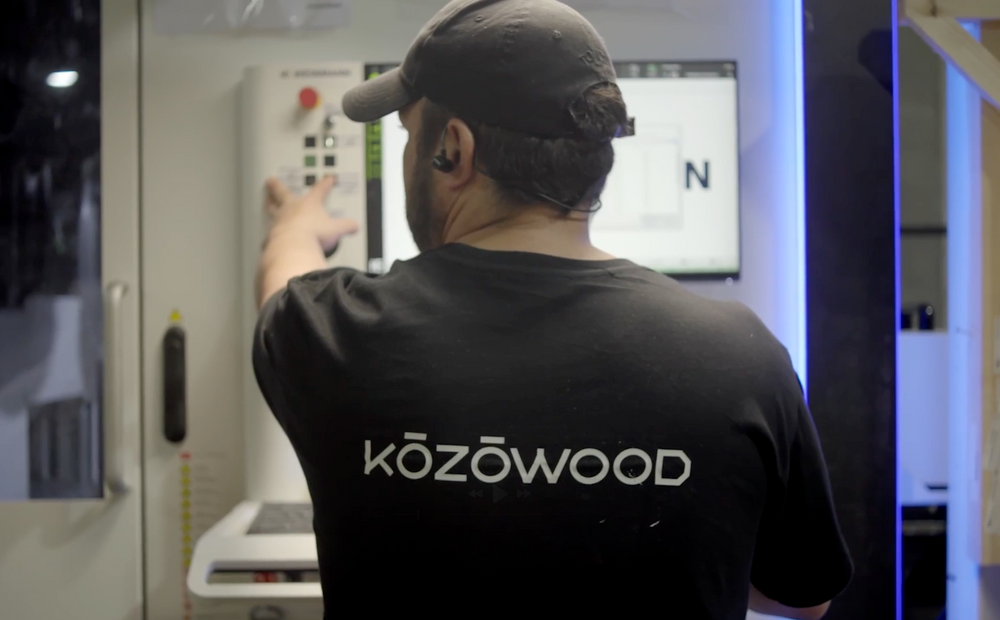(01)
Net Zero
What is Net Zero? What is Carbon Zero or Carbon Neutrality?
These concepts are increasingly important in the field of sustainability and refer to two balances:
1) The balance between the amount of energy consumed by a building and the amount of renewable energy that the building is able to generate. When a construction achieves Net Zero status, it means that there are no net carbon emissions associated with its energy consumption, contributing significantly to the reduction of the ecological footprint.
2) The amount of carbon associated with the construction of the building has two sources: the carbon emitted due to the energy consumed in the transformation, production, and transportation of construction materials and the construction process itself, known as "embodied carbon," and the carbon sequestered and stored when using organic materials such as wood or cork, known as "biological carbon."
At Kozowood Industries, we embrace both concepts through the use of wood construction methods such as CLT (Cross Laminated Timber) and Wood Frame. These methods not only utilize renewable and environmentally friendly materials but also enable the creation of highly energy-efficient buildings. Wood construction is a sustainable choice because wood is a natural resource that captures carbon dioxide during its growth, helping to mitigate the effects of climate change.
A Net Zero building is designed to be highly energy-efficient. This is achieved through various strategies, including advanced thermal insulation and the use of renewable energy sources such as solar panels. For Carbon Neutrality, in addition to using wood, we apply efficient construction technologies such as off-site construction and prefabrication. These approaches reduce material waste, increase assembly precision, and ensure excellent energy performance. By integrating these elements, Kozowood not only meets the criteria for Net Zero and Carbon Neutrality but also promotes sustainability and energy efficiency in all its projects. This approach benefits the environment and provides our clients with buildings that have reduced operating costs and superior comfort.
(02)
Net Zero & Carbon Neutrality
Why are Net Zero and Carbon Neutrality important?
The concept of Net Zero is fundamental for the future of sustainability and construction. In a global context where environmental concerns and the need to combat climate change are increasingly urgent, the construction of Net Zero buildings plays a crucial role.
Reduction of Carbon Footprint
Equally important, perhaps even more so, is its ability to drastically reduce the carbon footprint of buildings. 1 cubic meter of wood can remove 1 ton of CO2 from the atmosphere
With wood construction, one can go much further than achieving mere carbon neutrality, as the increase in biological carbon in the building can result in a significantly negative carbon footprint. In contrast, in conventional construction, even with "lower-emission" concrete/cement, the carbon footprint remains positive.
Our buildings, predominantly made of wood, have a negative carbon footprint. In a building that requires concrete foundations, using wood for the rest of the structure still allows it to achieve a negative carbon footprint. In the worst-case scenario (typically with 50% wood incorporation), we ensure the final footprint is zero. This is Carbon Neutrality (Carbon Zero). French legislation has recently mandated that all public buildings incorporate 50% wood, creating conditions to facilitate this transition.
Regarding energy, by balancing the amount of energy consumed with the amount of renewable energy generated, Net Zero buildings eliminate the net carbon emissions associated with their energy consumption. This is essential for mitigating the effects of climate change and reducing the amount of greenhouse gases in the atmosphere.
Types of Energy and Carbon Neutrality
Embodied Energy: It refers to the amount of energy required to produce, transform, and use construction materials, as well as to construct the building. Conventional construction already aims to reduce these emissions, such as in cement production.
Operational Energy: Operational Energy refers to the energy required to operate buildings once constructed. Net Zero construction aims for the highest possible energy efficiency rating, minimizing the energy needed to comfortably operate the building and utilizing renewable energy sources such as solar panels to balance energy consumption and production.
The pursuit of carbon neutrality is essential to combat climate change. The key is to potentially achieve a negative carbon footprint, pushing the concept further and significantly contributing to offsetting the positive footprint excesses of the rest of the sector. Concurrently, Net Zero buildings not only help reduce the demand for energy from non-renewable sources but also contribute to energy efficiency and the reduction of greenhouse gas emissions. This effort is vital to achieving global climate goals and ensuring a more sustainable future.
Sustainability in Construction
Wood construction methods like CLT and Timber Frame are highly effective in promoting sustainability. Wood is a renewable resource that captures carbon dioxide during its growth, helping to maintain ecological balance. Additionally, wood construction generates less waste and utilizes materials that can be recycled or reused, thereby reducing environmental impact. This means that buildings with wood have a much more favorable Life Cycle Assessment (LCA) compared to conventional buildings, contributing to the requirements of the Circular Economy.
Energy Efficiency and Reduced Costs
Net Zero buildings are highly energy-efficient, resulting in lower operational costs. Advanced construction techniques such as high-quality thermal insulation and the use of renewable energy sources ensure that buildings maintain a comfortable temperature with reduced reliance on artificial heating and cooling. This energy efficiency translates into significant savings on energy bills, benefiting both owners and the environment. These buildings utilize heat pumps for climate control, heat recovery in ventilation systems, efficient lighting, and induction cooking. These technologies meet reduced energy needs efficiently, aligning with today's most advanced equipment.
Therefore, it also becomes easier to offset this energy (NZEB - Net Zero) with a smaller set of photovoltaic panels.
Well-being and Comfort
In addition to environmental and economic benefits, Net Zero buildings provide a high level of comfort and well-being to their occupants. Wood construction offers a healthy indoor environment with better air quality and a natural, welcoming atmosphere. The use of non-toxic materials and construction techniques that ensure good ventilation contribute to a healthier living space.
The Issue of Embodied Carbon
It also refers to embodied carbon, which is the carbon generated during the production, transformation, and handling of materials used in building construction, such as concrete, brick, tile, glass, and metals, including the construction process itself. Traditional construction seeks to reduce these carbon emissions, but without the use of wood, it is not possible to eliminate them completely. Prefabrication, which some companies already use, also contributes to the carbon footprint and is increasingly being adopted in conventional construction practices.
Contribution to a Sustainable Future
By adopting Net Zero and Carbon Zero construction practices, construction companies are contributing to a more sustainable future. This innovative approach, committed to sustainability, not only helps protect the environment but also sets a benchmark for the construction industry. Leading by example, these companies inspire others in the industry and beyond to embrace more ecological and responsible practices.
The combination of Carbon Negative wood construction and Net Zero practices allows for the possibility of truly carbon-zero or carbon-neutral buildings, and even buildings with a negative carbon footprint. However, it's important to distinguish that a building without wood can be Net Zero but not necessarily Carbon Zero!
(03)
Net Zero in the Construction Sector
How Net Zero Applies in the Construction Sector?
The concept of Net Zero is crucial in the construction sector to address the challenges of climate change and promote sustainability. Net Zero buildings balance the amount of energy consumed with renewable energy generated on-site, resulting in a net zero carbon footprint associated with energy consumption. This is achieved through efficient design and engineering practices that maximize the use of natural light, ventilation, and advanced thermal insulation. Additionally, installing solar panels, wind turbines, and other technologies that generate clean energy on-site are essential components for achieving this balance.
The use of construction technologies such as off-site construction and prefabrication also significantly contributes to Net Zero goals, as these techniques reduce material waste and increase assembly precision. Operational efficiency is another crucial aspect, involving the implementation of efficient heating, ventilation, and air conditioning (HVAC) systems, as well as low-energy lighting and appliances.
The European Union aims to achieve carbon neutrality by 2050, with the building sector playing a crucial role. Buildings can potentially have a negative carbon footprint, contributing to the overall energy balance. It is essential to construct carbon-neutral buildings by combining conventional materials with wood. Incorporating 50% wood, as mandated by the French government in 2021 for new public buildings, can help achieve this neutrality.
In summary, the application of the Net Zero concept in the construction sector involves a holistic approach that integrates efficient design, sustainable materials, renewable energy, and ongoing maintenance to create buildings with a neutral environmental impact. These practices not only benefit the environment but also provide long-term savings and improve the comfort and quality of life for occupants.

Image by Kozowood Industries
(04)
Wood & Net Zero
The importance of wood achieving Net Zero in construction
Wood is a renewable resource that offers multiple advantages for sustainable construction. The use of wood, especially in systems like , is crucial for achieving Net Zero in construction due to its carbon sequestration capacity. During their growth, trees capture and store carbon dioxide (CO2), thus helping to reduce the amount of carbon in the atmosphere.
Compared to conventional building materials like cement and steel, wood requires less energy for production and processing, resulting in lower carbon emissions throughout the building's lifecycle. Additionally, wood has natural thermal insulation properties that contribute to the energy efficiency of buildings, reducing the need for artificial heating and cooling. Wood is also recyclable and biodegradable, making it a sustainable choice aligned with the principles of the circular economy.
(05)
Kozowood Industries & Net Zero
How does Kozowood Industries Implement Net Zero?
Processes of Sustainable Construction
The Net Zero philosophy is ingrained in the activities of Kozowood Industries, empowered by a series of innovative strategies ensuring sustainable construction practices and minimizing environmental impacts. Indeed, one of the company's pillars is the use of sustainable construction processes that utilize certified wood, ensuring that raw materials come from responsibly managed forests. This approach not only helps achieve a negative carbon footprint but also promotes forest regeneration, which is essential in combating global warming. Wood construction, particularly through technologies like CLT and Timber Frame, allows Kozowood to create robust and sustainable structures with zero carbon emissions throughout the buildings' lifecycle.
Energy Efficiency
Kozowood places particular emphasis on the energy efficiency of the buildings it constructs. Wood, its sole building material, serves as an excellent thermal insulator. As a result, Kozowood buildings can maintain comfortable indoor temperatures, thereby reducing the need for high-energy-consuming heating systems. In addition to lowering carbon dioxide emissions, these characteristics also decrease costs associated with residential energy consumption.
(06)
Future Vision
Future Vision of Kozowood for Sustainability
A Kozowood Industries apresenta uma visão futura focada na liderança sustentável no setor da construção. Um exemplo neste sentido é a aquisição das certificações PEFC (Programme for the Endorsement of Forest Certification) e FSC (Forest Stewardship Council). Estas certificações asseguram que toda a madeira utilizada pela empresa é proveniente de florestas geridas de forma responsável e sustentável. Estas certificações são um exemplo do compromisso contínuo da Kozowood com a sustentabilidade e a preservação ambiental.
In addition to certifications, Kozowood also invests consistently in technological innovation and advanced methods of sustainable construction. The company aims to expand the use of CLT and other wood construction technologies that not only enhance the structural and energy efficiency of buildings but also significantly reduce carbon footprint. With the new manufacturing facility employing automated processes for wood panel production, Kozowood is poised to handle large-scale operations, enabling faster and more sustainable housing production.
Therefore, Kozowood not only contributes to mitigating climate change but also sets new standards for sustainability in the construction industry, inspiring other companies and communities to adopt ecological and responsible practices.

Image by Kozowood Industries

